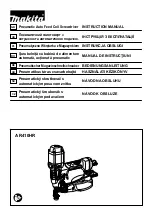
9
Steel sheet backing
Wood backing
Screw length
Steel sheet thickness
0.8 mm
Steel sheet thickness
0.6 mm
Steel sheet thickness
0.6 mm
(1)
(2)
(1)
(1)
(1)
(1)
(1)
(1)
(1)
(1)
(2)
(2)
(1).(2)
25 mm
28 mm
32 mm
41 mm
009793
Suitable for use on general plasterboard with
thicknesses of 9.5mm, 12.5mm and 15mm.
Steel sheet backing up to 0.8mm thick can be worked
on (screws cannot be driven into layered steel sheet
backing).
Always use Makita genuine linked screws.
We recommend that in normal situations the driver be
used in Switching Mode (1), and set to Switching Mode
(2) when screws cannot be driven for lack of power.
ASSEMBLY
Loading Screws
CAUTION:
•
Always disconnect air hose from main unit before
loading screws.
•
If the main unit is operated by mistake, it may lead
to personal injury.
1.
Disconnect air hose.
2.
Press down lever while opening door.
Fig.7
3. Open
magazine
cap.
Fig.8
4.
Load screws into magazine.
5. Pull out lead screw as far as driver guide and
then close magazine cap.
6.
Completely load lead screw into screw channel.
At this point, check to see that screw is
completely set in feeding claw.At this time, if the
screw cannot be set because the bit has come
down as far as the driver guide, turn the main unit
upside down (driver guide is on top), and return
the bit to its designated position.
7.
Slowly close door until lever stops fully.
Fig.9
OPERATION
How to Drive Screws
CAUTION:
•
The utilized air pressure must be between 1.76
and 2.26MPa. Do not repeatedly drive screw(s) in
on top of a screw that has been already driven in.
•
This driver is not an impact gun, so it requires a
reasonable amount of pressing.
•
If the main unit is not pressed sufficiently, the
screw may not drive in flush to workpiece, or come
out.
•
Always press the end of the discharge nose at a
right angle onto the workpiece and then drive in
screw. We recommend that you use the
intermitent-drive action to ensure proper screw
driving.
Fig.10
Fig.11
First, lightly press the end of the contact arm onto a
workpiece.
Next, pull the trigger.Here, do not release the trigger
until the motor stops running.Note that if the trigger is
released too soon, the screw may not be driven in flush
to workpiece, and/or the screw feed may be impaired.
Switching between intermitent drive and
continuous drive
Intermitent Drive Method
Fig.12
Fig.13
Intermitent drive is where the contact arm is pressed
against a workpiece, and the trigger pulled to drive in
one screw.
Set the switching lever to the
position to set driver
to "Intermitent Drive Mode".
(1) Press contact arm against workpiece.
(2) Pull
trigger.










































